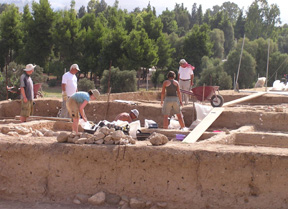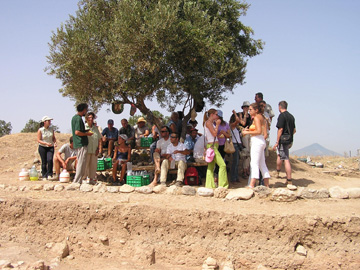
SOME OF THE AIMS OF CURRENT EXCAVATIONS ON THE SETTLEMENT OF XEROPOLIS
The significance of Lefkandi as one of the most important Late Bronze and Early Iron Age sites in the Aegean is widely known. Before the launch of the current excavation in 2003, our knowledge of the Early Iron Age history of the site depended mostly on the rich cemeteries excavated by the British School at Athens and the Greek Archaeological Service. Yet only a small part of the contemporary settlement of Xeropolis had been investigated in the 1960s. Having already excavated a large number of the tombs, it became apparent that it was important to go back to Xeropolis to excavate the settlement and gain important insights into the relationship between the living and the dead during the Early Iron Age.
 |
Another important issue for the understanding of the period concerns the transition from the Late Bronze to the Early Iron Age in the Aegean. Xeropolis was a major settlement in the Late Helladic IIIC period and from what we know from the funerary evidence it was a flourishing Iron Age site too. Thus it is of great importance to trace its history during the transitional stage from the Late Bronze to the Early Iron Age. Moreover, since the site was occupied both in the Late Helladic IIIC and the Geometric periods, an understanding for urban developments in post-palatial Greece might be possible after further investigation. An extra bonus for the archaeologist of Early Greece is the fact that the site was not occupied in later periods. Thus, Lefkandi is ideal for fully revealing the history of the Aegean during this period.
 |
Other issues which are important for the archaeology of the period include scrutinizing the relative chronological sequences to see whether those suggested by finds from the cemeteries agree with stratigraphical sequences in the settlement. The importance of such an exercise becomes clear when we consider, for example the number of Greek finds discovered outside the Aegean. The number of Euboean pots found at sites in the Eastern and more recently in the Western Mediterranean too increases every year. The importance of their dating is well known as they play a significant role in fixing relative and absolute chronology between Greece and both the East and the West. New stratigraphical sequences from Lefkandi would challenge previous and recent developments in this area and confirm or refute the established chronological sequences of the Early Iron Age. In combination with the more traditional study of the local pottery we are now engaged in a project endorsing radiocarbon dating in collaboration with the Oxford Radiocarbon Accelerator Dating Service. The results of such collaboration can only be significant and exciting.
 |
Another issue concerning the study of ceramics is that since the earlier excavations on the site such studies have moved on. In addition to the reconstruction and dating of stratified sequences, more pottery is now retained and studied in order to understand its meaning in relationship with its context and function. In this new approach of ceramic studies, Lefkandi can again play a major role because of its continuous occupation from the Late Bronze to the Early Iron Age. Moreover, the role of ceramics in understanding the regional and inter-regional mechanics of exchange have also moved forward since the earlier excavations. The importance of bringing up to date the ceramic studies at Lefkandi becomes even more crucial with the recent discoveries of Euboean style pottery from Oropos and the new excavations of Early Iron Age buildings and levels at Eretria and Amarynthos.
Finally, complementary studies are taken place to understand the ancient landscape and the formation of the tell during its long period of use. A pilot study is also being conducted in which soil samples from floors and sections are taken in order to establish patterns of space use and function of structures and to identify, with the help of micromorphology and multi-element soil analysis, internal and external space. Aspects of the diet and economy of these communities might also be better understood with the systematic collection of bio-archaeological remains, animal bones, and shells.
Home > New Excavations>Complementary Studies